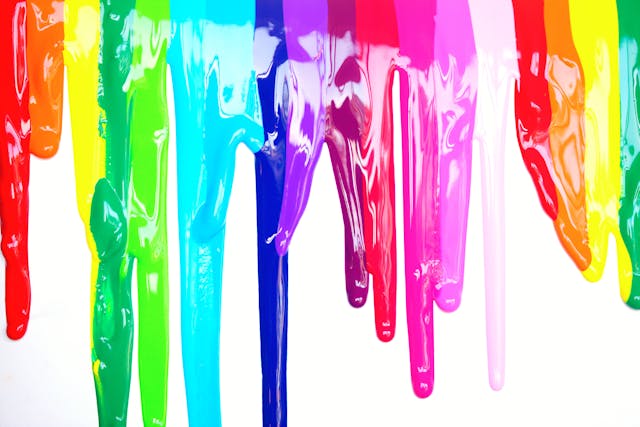In the intricate maze of communication, metaphors function as a lighthouse in a storm, casting light on complicated notions and nebulous ideas via familiar juxtapositions. A metaphor is fundamentally a comparison that sheds light on the links between varying components at its heart. It’s an instrument wielded by those skilled in communication, teachers, and leaders alike to enhance comprehension, provoke thoughtfulness, and nurture engagement. Within the sphere of verbal and written expression, a vibrant metaphor may hold exceptional influence – it can easily conjure images and stir emotions to leave an indelible mark.
This principle is borrowed by the world of design to inject vivacity into visual storytelling. In much the same way that spoken or penned metaphors make elusive concepts more understandable; analogous colors introduce unity and coherence into designs. Analogous colors are color groupings found next to each other on the color wheel. They can be deployed tactically to forge an artistic link between disparate sections of a design—thereby subtly directing the viewer’s gaze for easier understanding. Deep expertise in analogous colors’ application within design empowers professionals with creating visuals which not only delight aesthetically but also communicate profoundly.
The Role of Analogies in Communication
In the vast expanse of human communication, analogies secure a crucial foothold. Their reach extends far and wide, spilling over the brims of everyday chit-chat. The act of drawing similarities is an inherent part of our cognitive processes – and it’s this very nature that analogies tap into, nurturing understanding, clarification, and persuasion during discourse.
The power they wield is unmistakably visible in artistic domains where crafting analogous color schemes carries significant weight. Analogous colors often share borders on the color wheel and when skilfully employed can construct aesthetically pleasing layouts.
Let’s consider an example to illustrate this point: analogous colors might span from the rich tones radiating from a sinking sun – encompassing fiery reds, vibrant oranges, and molten gold – to calming blends of blues and greens reflective of serene coastal vistas or tranquil woodland scenes.
It must be noted though that their application isn’t restricted merely to tangible forms of art but also permeates digital realms like web design, animation as well as advertising- basically any field necessitating visual storytelling. In these areas too analogous hues have proven effective at setting atmospheres, directing viewer attention while subtly conveying narrative intent without reliance on verbal cues.
Thusly do analogies reign supreme – acting as indispensable instruments for enhancing communicative efforts via inference-based relatability.
Different Types of Analogies and Their Uses

Analogies, mysterious yet enlightening entities, exist in a myriad of incarnations. They span from elucidating intricate scientific notions to augmenting the impact of teaching within learning environments. One particular manifestation is known as the “Analogous colors palette,” an analogy revered within the spheres of visual arts and design. This peculiar comparison employs hues that neighbor each other on the chromatic wheel, thereby crafting a vivid portrayal of harmony and unity.
This principle morphs into an invaluable instrument at the disposal of artists or designers who select their color palette with prudent discernment so as to conjure specific emotional responses or guide attention.
Another intriguing specimen of analogical application is encapsulated in “Analogous colors in art”. Artists harness this tool with deftness, weaving certain moods into their masterpieces. The warm analogous shades like ruby reds, fiery oranges and sunny yellows can be manipulated to portray vibrancy, ardor or joyfulness; conversely cool analogous tints such as serene blues, verdant greens and regal purples can infuse tranquility or serenity into artworks.
Grasping these color analogies not only permits enhanced comprehension of artistic works but also arms creators with potent means to convey their intended narrative more potently. Acknowledging such subtle dimensions inherent in analogies could lay stepping stones toward a communication domain steeped in richness.
The Process of Creating Effective Analogies
In the process of crafting powerful analogies, adopting a methodical approach is unavoidable, as perplexing as it may seem. The initial stage demands an intensive scrutiny of the topic at hand; in this case, our emphasis leans towards discovering and distinguishing the elements set for comparison. It’s somewhat like combing through various shades within a monochromatic color spectrum, with the aim to discern delicate differences in hue, value, saturation and luminosity.
The subsequent stage entails aligning these scrutinized elements with an intuitive scenario that offers enhanced comprehension of said elements – this time around we welcome into focus analogous colors as they burst onto scene serving as a perfect exemplar. In much similar fashion to how both monochromatic and analogous hues establish harmony to give birth to an aesthetically pleasing outcome; effective analogies too should possess such harmonious ties between their compared components and context. It becomes crucial not to lose sight of those intricate details and characteristics inherent in each element – just like one mustn’t disregard the diverse yet cohesive aspects found within any analogous color scheme when embarking on design planning.
The Impact of Analogies on Cognitive Processes
Analogies, like dexterous cognitive alchemists, transmute elusive abstractions into palpable entities. They weave a tapestry of understanding that spans the chasm between uncharted territories and well-trodden paths. By drawing parallels with less intricate, everyday phenomena or objects, analogies act as catalysts in simplifying thought processes.
This accelerates the absorption of fresh insights broadening one’s mental horizons and enriching their repository of knowledge. The transformative prowess inherent in analogies transcends mere comprehension to activate cerebral functions such as problem-solving, decision-making, visualization and creativity.
By recasting mind-boggling enigmas or abstract situations into frames within the grasp of an individual’s bank of familiarity, they make it more mentally navigable. This implies that analogies spark cognitive agility prompting individuals to venture beyond conventional frameworks and explore a rich array of perspectives and alternate solutions.
Employing Analogies in Everyday Conversation
In the intricate dance of daily conversations, analogies twirl in adding a potent undercurrent of effectiveness to communication. They act as construction beams, bridging the chasms between wildly disparate concepts and ideas, nurturing an all-encompassing comprehension of contextual nuances. Analogies, with their innate propensity for comparison and metaphorical lyricism stand tall in the nebulous realm of thoughts. They offer sturdy stepping stones that simplify labyrinthine ideas.
Moreover, they wield an unrivaled ability to sketch resonant references that anchor discussions more firmly into recognizable landscapes – thereby making exchanges not only more relevant but also relatable and consequently engrossingly engaging.
The weaving of analogies into everyday chatter is delicately layered yet leaves indelible imprints. Within dialogues, a strategically positioned analogy can function like a spotlight — bringing clarity to perspectives or amplifying arguments while stirring ripples across listener’s thought pools. For example, within the corporate arena’s complex chessboard game dynamics, professionals often harness analogies as translators; rendering convoluted financial jargon into bite-sized vernacular morsels.
Conversely during interpersonal interactions laden with emotional undertones , analogies morph into empathetic bridges providing glimpses into another’s vantage point. In essence the clever deployment of analogies paves way towards richer conversational tapestries weaved beyond surface-level exchanges.
The Artistry Behind Vibrant and Engaging Analogies
The genesis of vibrant and magnetic analogies is not a product of sheer coincidence. It demands an acute power of scrutiny, profound comprehension of the subject at hand, and a cunning manipulation of linguistic apparatus. The craft involved frequently resides within the capability to dexterously draw connections between two ostensibly disparate themes in such a way that it renders the intangible as tangible while also extending an invitation to delve deeper into understanding. This craftsmanship ought not be downplayed given its invaluable contribution towards transmuting intricate concepts into understandable language.
Breathing life into a vivid analogy is tantamount to crafting an image with words. It includes encapsulating subtleties, stacking viewpoints, and utilizing an optimal mix of ingenuity and rationale. It’s a course requiring the intertwining threads of both analytical thinking and imaginative flair so as to render abstract ideas accessible and relatable. In essence, it’s akin to performing ballet between intellectuality and fantasy—constructing a bridge spanning from known territories onto grounds still awaiting exploration. Such nimble footwork infuses vitality into our communication realm by transforming insipid statements into riveting narratives.
FAQs
Immersing ourselves in the world of analogies, we’ll discover that it’s a comparative dance between two entities, usually forged to clarify or enlighten. It’s akin to lighting a candle in the cognitive dark, casting shadows on shared similarities between distinct concepts.
Like threads woven into the fabric of communication, analogies add depth and texture. They morph complex ideas into simpler forms by replacing unfamiliar notions with well-known counterparts, serving as bridges for effective and transparent conversational flow.
Analogical tapestry comprises several patterns – literal ones mirroring direct comparison; figurative ones illuminating metaphorical connections; symbolic ones symbolizing deeper correlations. These versatile tools are employed across different terrains – literature where they deepen narrative layers; education where they facilitate comprehension; everyday chatter for demystifying complexities through simplicity.
Crafting potent analogies is like sculpting from raw thought clay. It involves understanding your conceptual model, choosing a familiar counterpart that mirrors it aptly and then molding this relationship articulately into words. Ensuring relevancy in choice makes certain that these linguistic sculptures convey complexity simply yet effectively.
A swirling vortex of cognitive processes gets stirred up when encountering an analogy. By drawing parallels to known realms they kindle critical thinking mechanisms and ignite problem-solving circuits within us aiding better retention and comprehension of intricate data clusters.
Add some sparkle to mundane conversations by sprinkling them with aptly chosen analogies! Use them as keys to unlock complex ideas’ understanding doors or persuasive tools to make your point stand out. Remember – relevance, clarity and accurate representation are the three locks these keys need to open.
The heartbeat of a vibrant analogy lies in its creative crafting. It’s an intricate dance between selecting fitting comparisons and presenting them in an easily digestible yet engaging manner. This is where skill meets imagination, resulting not just in effective conveyance of complex notions but also creating memorable impressions.


